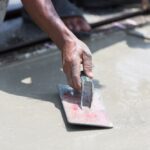When Is a Good Time to Repair Cracks in Concrete?
Have you noticed cracks in your concrete pavement? You’re probably wondering whether it’s too late to repair them this year, or if you’ll need to wait until spring. Generally, concrete crack repair is best done in the spring or autumn, which leaves you plenty of time to repair your pavement before the harsh winter weather sets in. Read on for concrete maintenance tips to help you preserve your pavement.
Why summer and winter are not good times for concrete crack repair
When the weather gets cold, your pavement shrinks. That makes the cracks even wider. If water freezes in the cracks, it can cause them to expand even more. By the time the spring rolls around, your pavement will be in much worse shape than it was before the snow started falling. If you try to repair the cracks in freezing weather, there’s a good chance that the crack seal or fill will freeze before it sets properly.
Similarly, summertime is a bad time to repair concrete cracks. The heat causes the concrete to expand, which means the cracks aren’t as open as they would be in moderate temperatures. You won’t be able to fill the cracks completely, which means you’ll need to finish the job when it gets cooler. The summer heat also causes the concrete repair products to set too quickly—and because it requires more water than in cooler months, your concrete won’t be as strong as it could be.
Repair your pavement in the spring or fall
Spring and fall are ideal for paving and concrete crack repair. The weather is cool but not freezing, and there are usually predictable periods during which it won’t rain. While every season has its own weather drawbacks, spring and fall are usually better bets.
Fall, especially, is a good time for concrete maintenance and crack repair. The cooler weather is less humid—since humidity can interfere with how quickly your concrete sets, the drier weather is a welcome change. Often, the days are still warm enough to encourage a full curing process, but not so hot that the concrete sets too quickly.
One more bonus to scheduling concrete crack repair in the fall is that contractors often have more openings. As the busy season slows down, concrete contractors tend to have availability, especially for smaller jobs.
A good concrete contractor will let you know whether they feel confident about the weather and how it will affect your pavement. If major storms or a cold snap occur, they may suggest rescheduling until conditions improve.
How concrete cracks are repaired
Depending on the size and location of the cracks, your contractors will pick the right method to seal your pavement. Cracks less than a quarter-inch wide can be filled with concrete caulk or liquid filler. Larger cracks may require different kinds of filler and special techniques to ensure the cracks don’t reappear as the pavement expands and contracts.
If you need help with concrete maintenance or concrete crack repair, call the team at Langenfeld Masonry & Concrete today.
More...
Categorised in: Concrete Contractor




